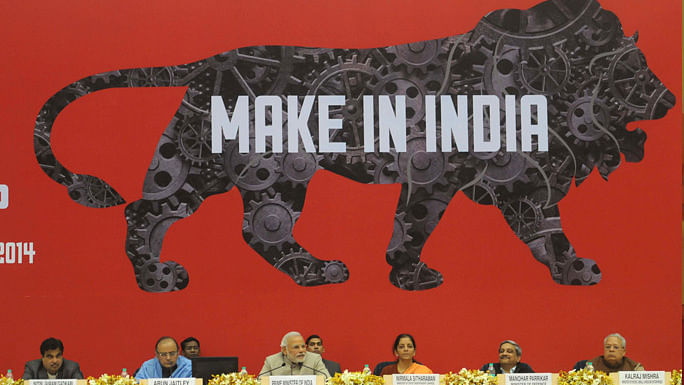New Delhi: Narendra Modi’s new government will work on a fresh strategy to boost the much-hyped Make in India programme.
Make in India, launched with much gusto by Modi in September 2014, is seen to have failed to live up to its promise. Industry leaders and experts have blamed this on a lack of economic reform needed to boost domestic manufacturing, a significant increase in imports, lacklustre investments and poor credit growth.
Sources said the government is now looking at incentivising companies which decide to invest in India, especially in the wake of the trade war between the US and China. The incentives could be in the form of tax benefits and easier clearances from local and central authorities.
“(The Centre) will chalk out ways to boost the Make in India programme, big ticket incentives for companies that invest in the country are on the anvil. However, the final contours will be chalked out once the new government is in place,” a senior government official told ThePrint.
Some of these plans could be announced in the budget, the official added.
The official said boosting this flagship programme, which is led by the Department of Industrial Policy and Promotion under the Ministry of Commerce and Industry, is key to creating jobs.
Besides, bilateral trade treaties including free trade agreements and the Regional Comprehensive Economic Participation — a proposed treaty between 16 countries — could be reviewed.
How Make in India failed
Make in India was officially launched in September 2014, with PM Modi having announced it in his first Independence Day speech from the Red Fort.
Make in India was aimed at turning India into a manufacturing powerhouse by removing bureaucratic sloth, easing procedures and removing red tape that stand in the way of investments. Although the programme initially impressed investors and policy makers, it failed to create the right environment for investments.
Make in India was also aimed at creating large scale employment. However, according to a leaked report of the National Sample Survey Office (NSSO), unemployment in the country hit a 45-year-high of 6.1 per cent in 2017, leaving the government red-faced, since employment generation had been one of the promises made by Modi in 2014. The NDA government was attacked by opposition parties during the 2019 election campaign for failing to create jobs.
While government officials denied reports of rising unemployment, the government’s think-tank NITI Aayog underlined the need to create quality jobs.
Also read: Modi’s key test with Trump will be to ensure Make in India doesn’t clash with Make in America
Trade treaties causing concern
Experts said time may be running out for Make in India, and with China being in a tight spot due to the intensifying trade war with the US, India must act fast to cash in. Countries such as Vietnam, Bangladesh, and the Philippines are fast catching up and turning out to be new hot spots for investment.
On the trade front, industry has repeatedly expressed its concern over India’s stand at the RCEP rounds. Two key metal associations — the Aluminium Association of India and the Indian Primary Copper Producers Association — have approached the government as well as the negotiating members with their concerns.
Policymakers and industry watchers fear that owing to the US-China trade war, the latter could resort to widespread dumping of goods, especially metals, including steel and aluminium. Sources said India’s trade treaties have only pushed imports and discouraged the setting up of manufacturing bases in the country.
The index of industrial production (IIP) growth for 2018-19 stood at 3.6 per cent, down from 4.4 per cent in the previous financial year. The huge decline in capital goods at -8.7 per cent, and intermediate goods (the pipeline for future output) at -2.5 per cent is a matter of concern, said an independent analyst.
“This underscores the fact that investments have dried up, and to revive Make in India, we need to understand the factors leading to this. A mere interest rate cut will not be enough,” the analyst said.
Ease of doing business
While India, currently ranked 77th on the Ease of Doing Business Index, has taken several measures to improve the business environment, including putting in place a vibrant Insolvency and Bankruptcy Code to resolve cases in a time-bound manner, sources said difficulties continue on the ground level.
Defence and automobile sectors
The NDA government has repeatedly underlined the need to strengthen manufacture of India’s defence equipment. According to the Observer Research Foundation, India, “despite having the fifth-largest defence budget in the world, procures 60 per cent of its weapon systems from foreign markets while Pakistan has sold more weapon systems to foreign customers than India”.
Policy paralysis and delays have stalled progress in whatever little is indigenously manufactured in the country. “This is another area of focus and we are hoping that things will move faster this time,” an industry expert said.
In the automobile sector, production has remained flat, according to data released by the Society of Indian Automobile Manufacturers, impacting exports.
Also read: Want ‘Make in India’ only — Ahmedabad taxman rants against Chinese water bottles




The writing on the wall is clear. India needs labour and land acquisition reforms. Without that, incentives are only window dressing. No company wants government interference while firing an incompetent employee or downsizing work force when the business is not doing well.
Good one